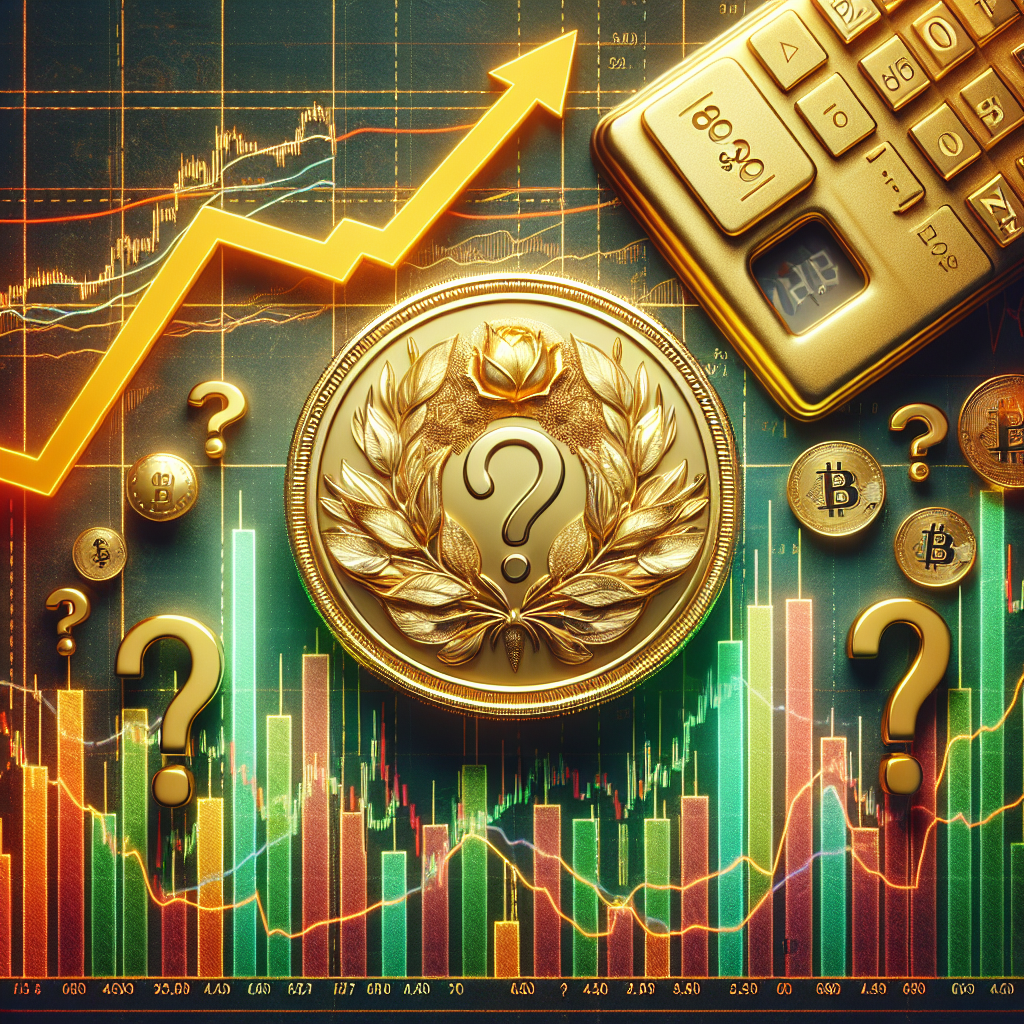“Gold: Timeless Value in a Changing World.”
Introduction
Gold has long been regarded as a symbol of wealth and a reliable store of value, often seen as a safe haven during times of economic uncertainty. Its allure as an investment has persisted through centuries, attracting both individual and institutional investors seeking to diversify their portfolios and hedge against inflation and currency fluctuations. However, in today’s rapidly evolving financial landscape, characterized by technological advancements, fluctuating interest rates, and the rise of alternative investment options like cryptocurrencies, the question arises: Is gold still a shining investment? This inquiry delves into the current relevance of gold in the modern investment portfolio, examining its performance, potential benefits, and challenges in the context of contemporary economic dynamics.
Historical Performance Of Gold As An Investment
Gold has long been regarded as a symbol of wealth and a reliable store of value, tracing its allure back to ancient civilizations. Its historical performance as an investment has been a subject of interest for both individual and institutional investors. To understand whether gold remains a shining investment today, it is essential to examine its historical trajectory and the factors that have influenced its value over time.
Historically, gold has served as a hedge against inflation and currency devaluation. During periods of economic uncertainty, investors have often turned to gold as a safe haven asset. For instance, during the 1970s, the world experienced significant economic turmoil characterized by high inflation and geopolitical tensions. In this context, gold prices soared, reflecting its role as a protective asset. The price of gold increased from approximately $35 per ounce in 1971, when the United States abandoned the gold standard, to over $800 per ounce by 1980. This dramatic rise underscored gold’s ability to preserve wealth in times of financial instability.
Transitioning into the 1980s and 1990s, gold’s performance was less spectacular. The global economy stabilized, inflation rates declined, and central banks implemented policies that fostered economic growth. Consequently, gold prices experienced a prolonged period of stagnation and even decline. However, this phase was not indicative of gold losing its luster as an investment. Rather, it highlighted the cyclical nature of gold’s performance, which is often inversely related to the strength of the global economy and the performance of other asset classes, such as equities and bonds.
As the new millennium dawned, gold once again captured the attention of investors. The early 2000s were marked by economic uncertainty, including the bursting of the dot-com bubble and the 2008 financial crisis. During these turbulent times, gold prices surged, reaching an all-time high of over $1,900 per ounce in 2011. This resurgence was driven by a combination of factors, including fears of inflation, currency debasement, and geopolitical instability. Gold’s performance during this period reaffirmed its status as a safe haven asset, capable of providing a buffer against economic shocks.
In recent years, gold’s performance has been influenced by a complex interplay of factors. The COVID-19 pandemic, for instance, triggered a renewed interest in gold as investors sought refuge from market volatility. Additionally, central banks around the world have continued to hold significant gold reserves, underscoring its enduring value as a strategic asset. However, the rise of alternative investments, such as cryptocurrencies, has introduced new dynamics into the investment landscape, prompting questions about gold’s future role.
Despite these challenges, gold’s historical performance suggests that it remains a viable investment option. Its ability to act as a hedge against inflation and currency fluctuations, coupled with its intrinsic value, continues to attract investors seeking diversification and stability. While the investment landscape is ever-evolving, gold’s enduring appeal lies in its historical resilience and its capacity to adapt to changing economic conditions.
In conclusion, the historical performance of gold as an investment reveals a pattern of resilience and adaptability. While it may not always deliver spectacular returns, its role as a safe haven asset and a hedge against economic uncertainty remains relevant. As investors navigate the complexities of the modern financial landscape, gold’s historical track record suggests that it will continue to shine as a valuable component of a diversified investment portfolio.
Factors Influencing Gold Prices In Today’s Market
Gold has long been considered a safe haven for investors, a tangible asset that retains value even in times of economic uncertainty. However, the factors influencing gold prices in today’s market are multifaceted and dynamic, reflecting a complex interplay of global economic conditions, geopolitical tensions, and market sentiment. Understanding these factors is crucial for investors seeking to determine whether gold remains a shining investment.
One of the primary factors affecting gold prices is the state of the global economy. In times of economic instability, such as during recessions or financial crises, investors often flock to gold as a store of value. This is because gold is perceived as a hedge against inflation and currency devaluation. For instance, when central banks implement expansive monetary policies, such as quantitative easing, to stimulate economic growth, the resulting increase in money supply can lead to inflationary pressures. In such scenarios, gold often becomes more attractive as it tends to hold its value better than fiat currencies.
Moreover, interest rates play a significant role in determining gold prices. Generally, there is an inverse relationship between interest rates and gold prices. When interest rates are low, the opportunity cost of holding non-yielding assets like gold decreases, making gold more appealing to investors. Conversely, when interest rates rise, investors may prefer interest-bearing assets, leading to a potential decline in gold demand. Therefore, the monetary policies of major central banks, particularly the Federal Reserve in the United States, are closely monitored by gold investors.
Geopolitical tensions and uncertainties also have a profound impact on gold prices. In times of political unrest or conflict, gold is often seen as a safe haven asset. For example, escalating tensions in the Middle East or trade disputes between major economies can lead to increased demand for gold as investors seek to mitigate risk. Additionally, gold’s role as a global reserve asset means that changes in the geopolitical landscape can influence central banks’ decisions to buy or sell gold, further affecting its price.
Furthermore, currency fluctuations, particularly those involving the U.S. dollar, are crucial in shaping gold prices. Since gold is typically priced in dollars, a stronger dollar can make gold more expensive for foreign investors, potentially reducing demand. Conversely, a weaker dollar can make gold more affordable and attractive, boosting demand. Therefore, factors that influence the dollar’s strength, such as trade balances, interest rate differentials, and economic data releases, indirectly impact gold prices.
Market sentiment and speculative activities also contribute to the volatility of gold prices. Investor perceptions and expectations about future economic conditions, inflation, and interest rates can drive speculative trading in gold markets. Additionally, the advent of financial instruments such as gold exchange-traded funds (ETFs) has made it easier for investors to gain exposure to gold, thereby increasing market liquidity and potentially amplifying price movements.
In conclusion, while gold continues to be regarded as a valuable investment, its price is influenced by a myriad of factors that reflect the broader economic and geopolitical environment. Investors must consider these factors, including economic conditions, interest rates, geopolitical tensions, currency fluctuations, and market sentiment, when evaluating gold’s potential as an investment. By doing so, they can make more informed decisions about whether gold remains a shining investment in today’s ever-changing market landscape.
Comparing Gold To Other Precious Metals
In the realm of precious metals, gold has long been regarded as a symbol of wealth and a reliable investment. However, as the financial landscape evolves, investors are increasingly considering other precious metals such as silver, platinum, and palladium. To determine whether gold remains a shining investment, it is essential to compare it with these alternatives, examining their unique characteristics, market dynamics, and potential returns.
Gold’s historical significance and stability have made it a cornerstone of investment portfolios. Its value is often seen as a hedge against inflation and currency fluctuations, providing a safe haven during economic uncertainty. However, silver, often referred to as “the poor man’s gold,” offers a different set of advantages. While it shares some of gold’s properties, such as being a store of value, silver is also an industrial metal. Its applications in electronics, solar panels, and medical devices contribute to its demand, potentially leading to higher volatility but also offering opportunities for significant gains.
Transitioning to platinum, this metal is rarer than gold and silver, which can make it an attractive investment option. Platinum’s primary use is in the automotive industry, particularly in catalytic converters for vehicles. This industrial demand can drive its price, but it also makes platinum susceptible to market fluctuations tied to the automotive sector’s performance. Consequently, while platinum can offer substantial returns, it also carries a higher risk compared to gold.
Palladium, another precious metal, has gained attention in recent years due to its critical role in reducing vehicle emissions. Like platinum, palladium is used in catalytic converters, but it has become more favored due to its efficiency and cost-effectiveness. The increasing demand for environmentally friendly vehicles has propelled palladium prices, making it a potentially lucrative investment. However, its market is relatively small and can be subject to significant price swings, which may deter risk-averse investors.
When comparing these metals, it is crucial to consider their liquidity and market accessibility. Gold is the most liquid of the precious metals, with a well-established market and numerous investment vehicles, such as bullion, coins, and exchange-traded funds (ETFs). Silver also enjoys a high level of liquidity, though not to the same extent as gold. In contrast, platinum and palladium markets are smaller and less liquid, which can pose challenges for investors seeking to enter or exit positions quickly.
Furthermore, the geopolitical landscape can influence the performance of these metals. Gold often benefits from geopolitical tensions, as investors flock to it as a safe haven. Silver, platinum, and palladium, while also affected by global events, are more closely tied to industrial demand and economic growth. This distinction can impact their performance during periods of geopolitical instability.
In conclusion, while gold remains a steadfast investment choice due to its historical stability and liquidity, other precious metals like silver, platinum, and palladium offer unique opportunities and risks. Investors must weigh these factors carefully, considering their risk tolerance, investment goals, and market conditions. By understanding the nuances of each metal, investors can make informed decisions about whether gold still shines as the best investment or if diversifying into other precious metals might yield greater rewards.
The Role Of Gold In A Diversified Investment Portfolio

In the ever-evolving landscape of investment opportunities, gold has long been regarded as a stalwart asset, often seen as a safe haven during times of economic uncertainty. As investors seek to build diversified portfolios, the question arises: is gold still a shining investment? To address this, it is essential to examine the role gold plays in a diversified investment portfolio and how it complements other asset classes.
Historically, gold has been valued for its intrinsic worth and scarcity, serving as a store of value across civilizations. In modern times, it continues to be a popular choice for investors looking to hedge against inflation and currency fluctuations. Unlike paper currency or other financial instruments, gold is a tangible asset that does not carry the risk of default. This characteristic makes it particularly appealing during periods of economic instability, when confidence in fiat currencies may wane.
Moreover, gold’s performance often exhibits a low correlation with traditional asset classes such as stocks and bonds. This means that when equities experience volatility or downturns, gold may not necessarily follow the same trajectory. Consequently, including gold in a diversified portfolio can potentially reduce overall risk and enhance returns. By acting as a counterbalance to more volatile investments, gold can provide a stabilizing effect, particularly during market turbulence.
In addition to its role as a hedge, gold can also serve as a strategic asset in a diversified portfolio. For instance, during times of geopolitical tension or financial crises, gold prices tend to rise as investors flock to its perceived safety. This behavior underscores gold’s function as a crisis commodity, offering protection against unforeseen events that may negatively impact other investments. Furthermore, central banks around the world continue to hold significant reserves of gold, underscoring its enduring value and importance in the global financial system.
However, it is crucial to recognize that gold is not without its drawbacks. Unlike stocks or bonds, gold does not generate income or dividends. Its value is primarily driven by market sentiment and supply-demand dynamics, which can lead to periods of price stagnation or decline. Additionally, the costs associated with storing and insuring physical gold can be significant, potentially eroding returns over time. Therefore, investors must carefully consider these factors when determining the appropriate allocation of gold within their portfolios.
In recent years, the advent of gold exchange-traded funds (ETFs) has provided investors with a more accessible and cost-effective means of gaining exposure to gold. These financial instruments allow investors to buy and sell gold without the need to physically store it, thereby reducing associated costs and logistical challenges. As a result, gold ETFs have become a popular choice for those seeking to incorporate gold into their investment strategies.
In conclusion, while gold may not be the panacea for all investment challenges, it remains a valuable component of a diversified portfolio. Its historical role as a hedge against inflation and economic uncertainty, coupled with its low correlation to other asset classes, makes it an attractive option for risk-averse investors. By carefully considering the potential benefits and drawbacks, investors can determine the appropriate level of gold exposure to achieve their financial objectives. As the global economic landscape continues to shift, gold’s enduring appeal as a shining investment is likely to persist, offering both stability and diversification in an ever-changing world.
Gold Vs. Cryptocurrency: A Modern Investment Debate
In the ever-evolving landscape of investment opportunities, the debate between traditional assets like gold and modern alternatives such as cryptocurrency has become increasingly prominent. As investors seek to diversify their portfolios and maximize returns, understanding the nuances of these two asset classes is crucial. Gold, with its centuries-old reputation as a safe haven, has long been a staple in investment portfolios. Its intrinsic value, derived from its physical properties and historical significance, has made it a reliable store of wealth. In contrast, cryptocurrency, a relatively new entrant in the financial world, offers a digital and decentralized approach to investment, characterized by its volatility and potential for high returns.
To begin with, gold’s enduring appeal lies in its stability and resistance to economic fluctuations. During times of financial uncertainty, investors often flock to gold as a hedge against inflation and currency devaluation. Its tangible nature provides a sense of security, as it is not subject to the same risks as digital assets, such as hacking or technological obsolescence. Moreover, gold’s limited supply and universal acceptance further bolster its status as a valuable asset. However, while gold’s stability is attractive, it is not without its drawbacks. The metal’s price can be influenced by geopolitical events, changes in interest rates, and shifts in supply and demand dynamics, which can lead to periods of stagnation or decline.
On the other hand, cryptocurrency represents a paradigm shift in the investment world, offering a decentralized and borderless alternative to traditional financial systems. Bitcoin, the most well-known cryptocurrency, has captured the imagination of investors with its meteoric rise in value and potential for substantial returns. The underlying blockchain technology promises increased transparency and security, appealing to those seeking innovative investment opportunities. Nevertheless, the cryptocurrency market is notoriously volatile, with prices subject to dramatic swings driven by speculation, regulatory developments, and technological advancements. This volatility can result in significant gains, but it also poses considerable risks, particularly for those unaccustomed to such fluctuations.
As investors weigh the merits of gold versus cryptocurrency, several factors must be considered. Diversification remains a key principle in investment strategy, and both asset classes can play a role in achieving a balanced portfolio. Gold’s stability can provide a counterbalance to the volatility of cryptocurrencies, offering a measure of protection during market downturns. Conversely, the potential for high returns in the cryptocurrency market can enhance overall portfolio performance, particularly for those willing to accept higher risk.
Furthermore, the choice between gold and cryptocurrency may also depend on an investor’s time horizon and risk tolerance. Long-term investors seeking steady growth and preservation of capital may find gold more appealing, given its historical track record and lower volatility. In contrast, those with a higher risk appetite and a shorter investment horizon might be drawn to the dynamic nature of cryptocurrencies, with the possibility of rapid gains.
In conclusion, the debate between gold and cryptocurrency as investment options is emblematic of the broader evolution of financial markets. While gold continues to shine as a symbol of stability and wealth preservation, cryptocurrency offers a glimpse into the future of digital finance. Ultimately, the decision to invest in one or both of these asset classes should be guided by individual financial goals, risk tolerance, and market outlook. As the investment landscape continues to evolve, staying informed and adaptable will be key to navigating the complexities of modern finance.
Economic Uncertainty And Gold’s Safe Haven Status
In times of economic uncertainty, investors often seek refuge in assets that promise stability and security. Gold, historically revered as a safe haven, has long been a preferred choice for those looking to protect their wealth against the vicissitudes of financial markets. The allure of gold as a stable investment is deeply rooted in its intrinsic value, scarcity, and historical significance as a universal medium of exchange. However, as the global economic landscape evolves, questions arise about whether gold still holds its status as a reliable safe haven.
To understand gold’s enduring appeal, it is essential to consider its performance during periods of economic turmoil. Traditionally, gold has been perceived as a hedge against inflation and currency devaluation. When inflation erodes the purchasing power of fiat currencies, gold often retains its value, providing a buffer for investors. This characteristic becomes particularly relevant during times of economic instability, when central banks may resort to expansive monetary policies that could lead to inflationary pressures. Consequently, gold’s ability to preserve wealth makes it an attractive option for risk-averse investors.
Moreover, gold’s role as a safe haven is underscored by its historical performance during financial crises. For instance, during the 2008 global financial crisis, gold prices surged as investors flocked to the metal in search of security amidst collapsing stock markets and failing financial institutions. Similarly, during the COVID-19 pandemic, gold prices reached record highs as uncertainty gripped global economies. These instances highlight gold’s resilience and its capacity to act as a financial anchor in turbulent times.
However, it is crucial to recognize that gold’s safe haven status is not without its challenges. In recent years, the rise of alternative investments, such as cryptocurrencies, has introduced new dynamics into the investment landscape. Cryptocurrencies, particularly Bitcoin, have been touted by some as “digital gold,” offering similar hedging properties against inflation and economic instability. While these digital assets have gained popularity, they also come with significant volatility and regulatory uncertainties, which may deter risk-averse investors from fully embracing them as a substitute for gold.
Furthermore, the opportunity cost of holding gold is another factor that investors must consider. Unlike stocks or bonds, gold does not generate income or dividends. In a low-interest-rate environment, this may not be a significant drawback. However, as interest rates rise, the appeal of gold may diminish compared to income-generating assets. Investors must weigh the benefits of gold’s stability against the potential returns from other investments.
In conclusion, while gold continues to hold its status as a safe haven asset, its role in an investment portfolio should be carefully evaluated in the context of broader economic conditions and individual investment goals. The metal’s historical performance during crises underscores its value as a hedge against uncertainty, yet the evolving financial landscape presents new challenges and opportunities. As investors navigate these complexities, gold remains a viable option for those seeking to safeguard their wealth, but it should be considered alongside a diversified portfolio that balances risk and return. Ultimately, the decision to invest in gold should be informed by a comprehensive understanding of its benefits and limitations in the ever-changing economic environment.
Future Trends In Gold Investment And Market Predictions
As we navigate the complexities of the global financial landscape, the question of whether gold remains a viable investment continues to intrigue investors and analysts alike. Historically, gold has been revered as a safe haven asset, offering a hedge against inflation and currency fluctuations. However, with the advent of new investment vehicles and the evolving economic environment, the future trends in gold investment warrant a closer examination.
To begin with, it is essential to consider the historical context of gold as an investment. For centuries, gold has been perceived as a store of value, largely immune to the vicissitudes of economic cycles. Its intrinsic value and limited supply have made it a preferred choice for those seeking stability in times of economic uncertainty. Yet, as we look to the future, several factors could influence the trajectory of gold investments.
One significant factor is the global economic outlook. In recent years, the world has witnessed unprecedented monetary policies, including quantitative easing and near-zero interest rates, which have fueled concerns about inflation. In such scenarios, gold often emerges as an attractive investment, as it tends to retain its value when fiat currencies depreciate. However, should central banks shift towards tightening monetary policies to curb inflation, the appeal of gold could diminish, as higher interest rates typically bolster the attractiveness of interest-bearing assets.
Moreover, technological advancements and the rise of digital currencies present both challenges and opportunities for gold investors. Cryptocurrencies, often dubbed “digital gold,” have gained traction as alternative stores of value. Their decentralized nature and potential for high returns have captivated a new generation of investors. Nevertheless, the volatility and regulatory uncertainties surrounding cryptocurrencies may deter risk-averse investors, thereby sustaining interest in gold as a more stable option.
In addition to these economic and technological factors, geopolitical tensions continue to play a pivotal role in shaping gold market dynamics. Historically, periods of geopolitical instability have driven investors towards gold, seeking refuge from potential market disruptions. As global tensions persist, whether due to trade disputes, military conflicts, or political upheavals, gold is likely to remain a critical component of diversified investment portfolios.
Furthermore, the environmental and ethical considerations surrounding gold mining are increasingly influencing investment decisions. As investors become more conscious of sustainability, the demand for responsibly sourced gold is expected to rise. This shift could lead to a premium on ethically mined gold, potentially impacting market prices and investment strategies.
Looking ahead, market predictions for gold investment are varied. Some analysts foresee a bullish trend, driven by ongoing economic uncertainties and inflationary pressures. Others predict a more tempered outlook, citing potential interest rate hikes and the growing allure of alternative investments. Regardless of these differing perspectives, it is clear that gold will continue to play a significant role in the global investment landscape.
In conclusion, while the future of gold investment is subject to a myriad of influences, its enduring appeal as a hedge against economic instability remains undeniable. As investors weigh the potential risks and rewards, gold’s status as a shining investment will likely persist, albeit with evolving dynamics shaped by economic, technological, and geopolitical factors. Thus, for those seeking to navigate the complexities of future investment trends, gold remains a compelling consideration, offering both challenges and opportunities in an ever-changing market.
Q&A
1. **What factors influence the value of gold as an investment?**
Gold’s value is influenced by factors such as inflation rates, currency fluctuations, geopolitical stability, central bank policies, and supply-demand dynamics.
2. **How does gold perform during economic downturns?**
Gold often acts as a safe-haven asset during economic downturns, maintaining or increasing in value as investors seek stability.
3. **What are the benefits of investing in gold?**
Benefits include portfolio diversification, inflation hedging, and protection against currency devaluation.
4. **What are the risks associated with investing in gold?**
Risks include price volatility, lack of yield (no dividends or interest), and potential for market manipulation.
5. **How does gold compare to other investment options like stocks or bonds?**
Gold typically offers lower long-term returns compared to stocks but provides a hedge against market volatility and inflation, unlike bonds which offer fixed income.
6. **What forms can gold investments take?**
Gold investments can be made through physical gold (coins, bars), gold ETFs, mining stocks, and gold futures.
7. **Is gold a good investment for the future?**
Gold can be a good investment for those seeking diversification and protection against economic uncertainty, but it should be balanced with other asset classes for optimal portfolio performance.
Conclusion
Gold has historically been considered a safe-haven asset, often sought after during times of economic uncertainty and inflation. Its value is driven by factors such as geopolitical tensions, currency fluctuations, and market volatility. While gold does not generate income like stocks or bonds, it provides diversification and a hedge against inflation. In recent years, the rise of digital assets and changing economic conditions have influenced its appeal. However, gold’s intrinsic value, limited supply, and historical significance continue to make it a relevant component of a diversified investment portfolio. Ultimately, whether gold remains a shining investment depends on individual financial goals, market conditions, and risk tolerance.





